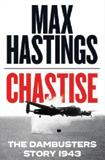|
Chastise - The Dambusters Story 1943
by Max Hastings
|
 Max Hastings has made the most of the rich seam provided by the Second World War and subsequent conflicts. And there are few richer seams to mine than the Dambusters Story, the mission to destroy German industrial capacity, immortalised in the 1955 film with Richard Todd as the heroic Guy Gibson and Michael Redgrave as Barnes Wallis. Throw in Eric Coates’s musical score for the film played by The Coldstream Guards Band, and it does for Brexit what Mel Gibson’s Braveheart did for the Scottish independence movement. Max Hastings has made the most of the rich seam provided by the Second World War and subsequent conflicts. And there are few richer seams to mine than the Dambusters Story, the mission to destroy German industrial capacity, immortalised in the 1955 film with Richard Todd as the heroic Guy Gibson and Michael Redgrave as Barnes Wallis. Throw in Eric Coates’s musical score for the film played by The Coldstream Guards Band, and it does for Brexit what Mel Gibson’s Braveheart did for the Scottish independence movement.
Hastings commands the narrative as though the reader is flying side-by-side with Gibson, brought to life in his great 1944 memoirs Enemy Coast Ahead. ‘Our noses were going straight for the point at which we had to cross the Dutch coast. The sea was as flat as a mill-pond, there was hardly a ripple, we were down to 50 feet, we nearly hit the drink and the boys must have thought I was mad’.
By late 1942, all the traditional animosities against Britain and its army, a trait Hastings has always rather chippily shared, were in full flow. Despite Monty’s victory at Alamein, the British Army was seen as a rather feeble and inept cousin to the Royal Navy, and the RAF after its sublime performance in the Battle of Britain. Churchill needed a man to take the fight to the enemy, someone as brutal and unimaginative as some of the Hitler’s henchmen. As Horace Walpole wrote, ‘No great country was ever saved by good men because good men will not go to the lengths that may be necessary ‘. Britain had such a man in the gimlet eyed ‘Bomber’ Harris, Air Officer Commanding Bomber Command.
Hastings describes Harris and his rather unusual personal life well. Harris certainly knew his way around the War Office, caring little as to where his punches landed, ‘Our generals will only learn to take tanks seriously when they eat hay and fart’. To a hapless group captain, ‘What have you done to impede the war effort today’. ‘Try ferrets’ to an air vice marshal who was forever coming up with complex and unworkable ways of destroying a target. The irony, of course, is that Barnes Wallis’s plan to use bouncing bombs to destroy the Mohne and Eder dams must have seemed to Harris, on the face of it, half-baked.
Hastings is on firm ground when he sets out the strategic challenges facing Britain, the egos involved and the competition for resources. At a human level, he has long recognised that military history palls only too quickly without the stories and anecdotes that bring the key players and their strengths and failings to life. Barnes Wallis is beautifully portrayed; Guy Gibson may well have been complex and not that ‘simpatico’ as a human being. He was a loner. Hastings, often judgemental, accepts this at face value, but he would have done better to show a more empathetic analysis of a man who flew 172 missions. At the age of 25, Guy Gibson had won the VC, DSO and Bar, and the DFC and Bar. His star shines into eternity.
The author has a well-oiled writing and researching machine, but occasionally this spills over into some sloppy sentence structure, ‘In the late summer of 1942, a situation obtained wherein Barnes Wallis had devised a revolutionary weapon, of which the scientific principles were agreed by most of the experts who studied them to be sound’. On the whole, however, Chastise reads exceptionally well and you do feel as though you’re part of the action as the drama enfolds.
The chapter on the 132 men who crewed the bombers and the aircraft they flew is fascinating stuff. They really did say ‘ Wizard Prang’. The crews had to gel and perform; if they didn’t, Gibson, ruthless in execution, would change or sack people without hesitation. If you were a navigator, 100 feet above the ground looking for landmarks, you needed the coolest and most focused of minds. A split-second loss of concentration from any crew member would incur a heavy cost. The word-portraits of the men who flew with Gibson, with all their foibles and eccentricities, are a gripping canvas. What may seem so strange today is that they were ready to embrace death, content that by their early 20s they had already led lives of meaning and often extraordinary excitement with comrades with whom they were happy to lay down their lives. Some of their final notes and letters to family and friends make for unbearable reading.
Overlaying this canvas remains the human tragedy. 52 aircrew died on the operation, two out of every five men. Some 1400 civilians died from the flooding, mostly slave labour for the Nazi war machine. Hastings presents the case that the tragic loss, particularly the civilian lives, places the validity of the operation into question. Close to half of all men in Bomber Command in the Second World War died. They’ve never received a dedicated campaign medal.
Paul de Zulueta
William Collins. www.harpercollins.co.uk
|
|